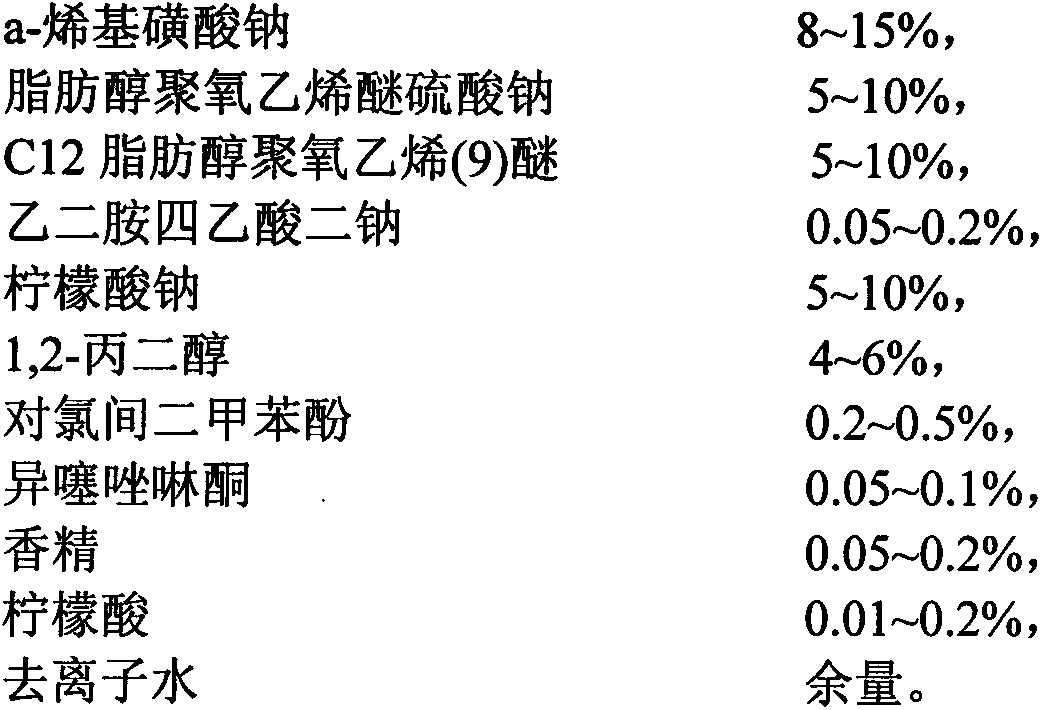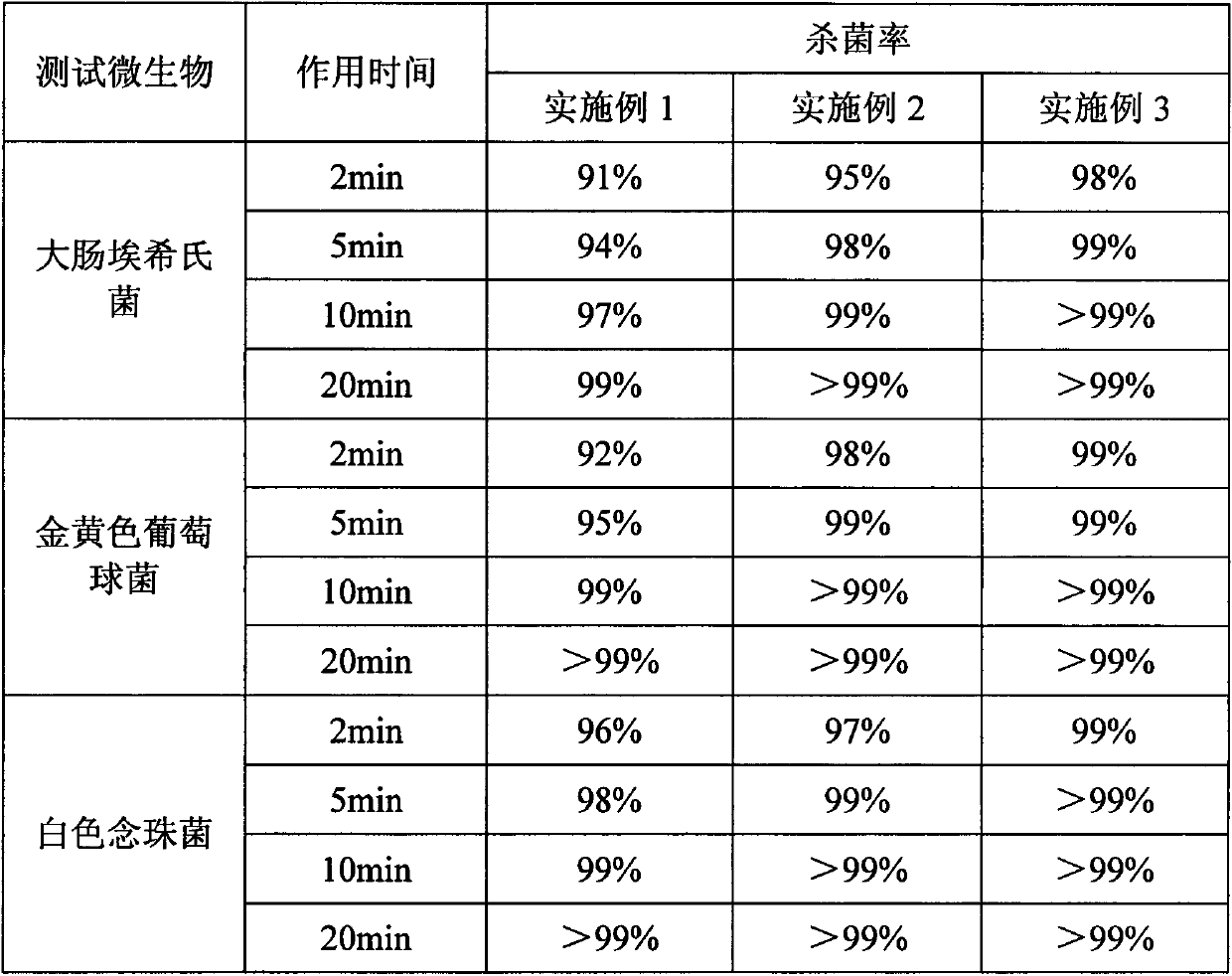Wet tissue for kitchen cleaning and disinfection
A technology for cleaning and disinfecting wet wipes, which can be used in household utensils, non-ionic surface active compounds, organic cleaning compositions, etc. It can solve the problems of bacteria breeding, toxicity, and volatility in the kitchen. Effective bactericidal effect
- Summary
- Abstract
- Description
- Claims
- Application Information
AI Technical Summary
Problems solved by technology
Method used
Image
Examples
Embodiment 1
[0037] Weigh 67.45 parts of deionized water in proportion and put them into a container, then add 8 parts of sodium α-alkenyl sulfonate, 10 parts of sodium fatty alcohol polyoxyethylene ether sulfate and 5 parts of C12 fatty alcohol polyoxyethylene (9) Ether, stirred until completely dissolved, then 0.2 parts of disodium edetate and 5 parts of sodium citrate were added to the solution and stirred until completely dissolved to obtain solution A.
[0038] Add 0.2 parts of p-chloro-m-xylenol to 4 parts of 1,2-propanediol and stir until completely dissolved to obtain solution B.
[0039] Add solution B, 0.1 part of isothiazolinone and 0.05 part of essence into solution A, stir evenly, and finally adjust the pH value of the solution to 6.0-8.0 with citric acid.
[0040] Drop the prepared liquid evenly on the spunlace non-woven fabric, the material of the non-woven fabric is a mixed material with a weight ratio of 50% viscose fiber and a weight ratio of 50% polyester, and the weight...
Embodiment 2
[0042] Weigh 59.42 parts of deionized water in proportion and put them into a container, then add 11 parts of sodium α-alkenyl sulfonate, 8 parts of sodium fatty alcohol polyoxyethylene ether sulfate and 8 parts of C12 fatty alcohol polyoxyethylene (9) Ether, stirred until completely dissolved, then 0.1 part of disodium edetate and 8 parts of sodium citrate were added to the solution and stirred until completely dissolved to obtain solution A.
[0043] Add 0.3 parts of p-chloro-m-xylenol to 5 parts of 1,2-propanediol and stir until completely dissolved to obtain solution B.
[0044] Add solution B, 0.08 part of isothiazolinone and 0.1 part of essence into solution A, stir evenly, and finally adjust the pH value of the solution to 6.0-8.0 with citric acid.
[0045] Drop the prepared liquid evenly on the spunlace non-woven fabric, the material of the non-woven fabric is a mixed material with a weight ratio of 50% viscose fiber and a weight ratio of 50% polyester, and the weight ...
Embodiment 3
[0047] Weigh 53.2 parts of deionized water in proportion and put them into a container, then add 15 parts of sodium α-alkenyl sulfonate, 5 parts of fatty alcohol polyoxyethylene ether sodium sulfate and 10 parts of C12 fatty alcohol polyoxyethylene (9) Ether, stirred until completely dissolved, then 0.05 parts of ethylenediaminetetraacetic acid disodium and 10 parts of sodium citrate were added to the solution and stirred until completely dissolved to obtain solution A.
[0048] Add 0.5 parts of p-chloro-m-xylenol to 6 parts of 1,2-propanediol and stir until completely dissolved to obtain solution B.
[0049] Add solution B, 0.05 part of isothiazolinone and 0.2 part of essence into solution A, stir evenly, and finally adjust the pH value of the solution to 6.0-8.0 with citric acid.
[0050] Drop the prepared liquid evenly on the spunlace non-woven fabric, the material of the non-woven fabric is a mixed material with a weight ratio of 50% viscose fiber and a weight ratio of 50%...
PUM
 Login to View More
Login to View More Abstract
Description
Claims
Application Information
 Login to View More
Login to View More - R&D
- Intellectual Property
- Life Sciences
- Materials
- Tech Scout
- Unparalleled Data Quality
- Higher Quality Content
- 60% Fewer Hallucinations
Browse by: Latest US Patents, China's latest patents, Technical Efficacy Thesaurus, Application Domain, Technology Topic, Popular Technical Reports.
© 2025 PatSnap. All rights reserved.Legal|Privacy policy|Modern Slavery Act Transparency Statement|Sitemap|About US| Contact US: help@patsnap.com



